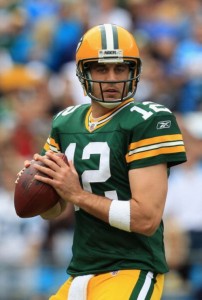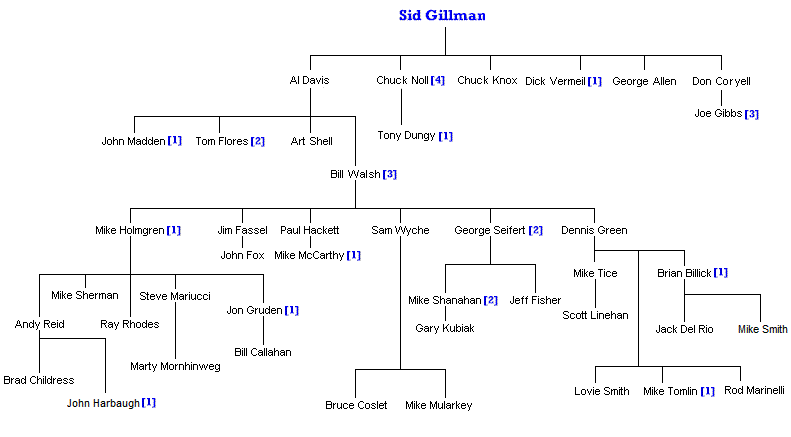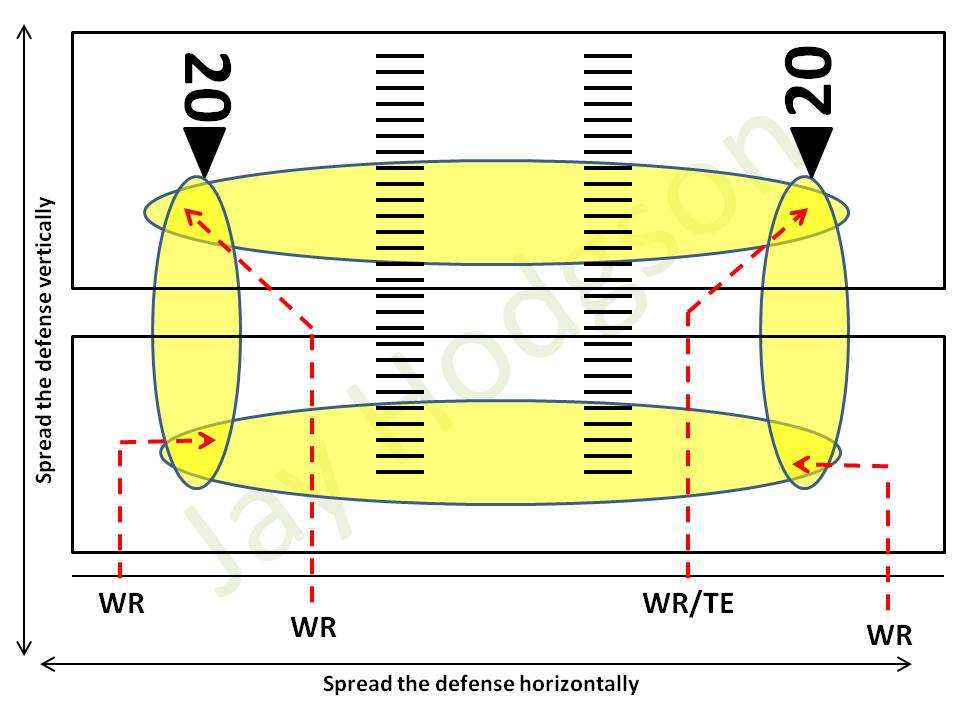

The Green Bay Packers offense is commonly referred to as a “West Coast Offense.” Likewise, Aaron Rodgers is often called a “West Coast Quarterback.”
For this article, I’ll take a look at some of the basic route combinations that exemplify the West Coast Offense, particularly those that you are likely to see on Sundays in Lambeau Field.
Disclaimer
This is an oversimplification for illustrative purposes. There are nearly endless route and personnel combinations. I’m only going to cover a few of the most common and basic concepts.
The West Coast Offense Defined
We must start any discussion about the West Coast Offense with Bill Walsh. He, of course, is the greatest West Coast Offense coach in NFL history and won three Super Bowls.
Over the years, the moniker “West Coast Offense” has come to mean many things, and if you ask three people to define it, you might get three different answers.
Certainly, offenses evolve over time in that ever-changing game of cat-and-mouse between the defenses, but some of the defining aspects of the West Coast Offense haven’t changed for decades.
I’ve come to understand the West Coast Offense to mean how Walsh modified Sid Gillman’s passing principles to match his own attack philosophy. Specifically, Walsh utilized a short, precision timing passing game to attack the underneath coverage to supplement the run game.
However, that doesn’t mean the West Coast offense is strictly a short passing game. There are plenty of vertical routes that come open once the underneath dominance is established.
Numerous of Walsh’s offensive-minded descendants, including current Packers head coach Mike McCarthy, former head coach Mike Holmgren, Jon Gruden, Mike Shanahan, and Brian Billick, have all won their own championships with their own flavors of Walsh’s offense.
By inspecting the coaching tree below, you can see that Walsh was a disciple of Sid Gillman, who I mentioned last week as being the father of the modern passing game. Gillman’s imprint revolutionized the game during the 1960s and his concepts are still widely used today.

I’m not saying that the passing game was primitive and haphazard before Gillman, but it certainly was more refined and orchestrated after him.
Gillman was a master of designing routes that targeted specific aspects of the defense and tied the timing of them to the number of steps the quarterback took while dropping back in the pocket.
What Gillman started, and Bill Walsh and his descendants finished, was the use of route combinations to specifically attack the defense.
To understand how Gillman’s and Walsh’s route combinations attack the defense, we must first understand the very basics of how the defense guards the field.
Essentially, the defense divides the field vertically, along with the yard lines, into “halves” with an underneath half and a deep half. Typically, the underneath half is 7 yards from the line of scrimmage and the deep half extends 15-20 from the line of scrimmage. This is just a baseline, of course; great variation does exist.

Additionally, the defense must guard sideline to sideline within each half.
Therefore, pass route combinations are designed to attack different aspects of the area the defense covers. Rather than attacking a specific defender, receivers attack positions on the field. This idea was a Gillman invention. He was a huge proponent of the “spread ’em and shred ’em” approach.
The Horizontal Spread Principle
The first way to attack the defense is to spread them horizontally to create wide lanes. This is one of the staples of the West Coast Offense, and it’s accomplished through the formation. The offense splits the outside wide receivers in “plus splits”, which means outside the numbers. Doing so spreads the defenders, making them each responsible for more area to cover.
From this alignment, the West Coast Offense can run the majority of their route combinations, which include slants and curls, to attack the underneath half. When Walsh originally drew up the West Coast Offense, it was dominated by short, underneath passes with precision timing.
The quarterbacks took short drop backs and quickly released the ball. This combination of shorter routes and quick throws is sometimes called a “tempo” or “timing” concept. Sometimes, they are called “high percentage” passes.
Gillman and Walsh both recognized that the offense could not rely only on spreading the defense horizontally simply because the defense would crowd the underneath half. If the box was crowded, the running game would most likely suffer.
The Vertical Spread Principle
Successful offenses also spread the field vertically. Deep route combinations open up the defense considerably and require them to guard much more of the field. It also pulls safeties out of the box.
The vertical passing game was popularized by Gillman, but it is experiencing another golden era in today’s NFL. Tom Brady and Aaron Rodgers have made livings running the four verticals passing attack. Streaks and post patterns are two ways to attack the deep half of the defense.
The High-Low Spread Principle
What makes modern offenses “modern” is their route combinations to simultaneously attack the defense both vertically and horizontally. This spreads the defense out and requires them to defend the entire field. Gillman was among the first to popularize this spread and shred approach.
If the defense is playing man-to-man coverage, each defender has to run farther. If they are playing zone coverage, each defender is responsible for a larger area on the field. Either way, it’s more taxing on the defense.
One of the most basic route combinations that attacks the defense from both perspectives is the “smash” concept.
The “smash” combination has the outside receivers running in routes and the outside receivers running fade routes. The in routes attack the underneath half and the fade routes attack the deep half.
Notice the alignment of the yellow ovals. The routes are spread in both the vertical and horizontal planes. The receivers on the same side of the field intersect on the same horizontal plane, but are separated by by vertical space. This poses coverage challenges for the defense.
Note: the smash doesn’t have to be run to both sides of the formation. I drew it as such to simply the rectangle that offenses establish to attack the defense. Different high-low spreads exist.
What separated Walsh from Gillman in the evolution of the passing offense was Walsh’s quest for the perfect passing attack using oblique geometry. He took the next step and carried the torch from Gillman.
The Oblique Triangle Spread Principle
Defenses always catch up to offenses if given enough time. They got smart to the coupled vertical and horizontal attacks and adapted zone/man combinations and pattern matching zones.
Traditional zones are usually uniform grids across the field. Pattern matching zones change size, shape, and location depending on what routes the offense was running at them. They were a way to defend route combinations.
If you’re good with spatial geometry, you can see how the above route combinations were typically of square or rectangle configurations. Accordingly, defenses countered with their own rectangles in zone coverage. Pattern matching zones change the size and location of the rectangles, negating the route combinations.
Walsh discovered how to beat these zones with an alternate passing geometry. By combining routes to make oblique triangles, his receivers could beat almost any flavor of zone, including pattern matching. The triangles also made man-to-man coverage less effective, so Walsh unleashed nearly unstoppable attacks.
To create triangles, three receivers need to align to one side of the formation. A very common triangle combination is illustrated below, which shows the inside receiver running a shallow out, the slot receiver running a fade, and the outside receiver running an in. The weak side receiver’s route is not as important in this concept, but they typically run deep to pull a safety with them.
The key to this triangle is the layering of the three corners. One corner is in the underneath half and another corner is in the deep half. The third corner is in the seam between the defensive halves. This puts tremendous pressure on the defense because the routes are no longer run along nice rectangles. The layering is oblique, which makes it harder to play pattern matching zone. Since receivers are crossing, man-to-man coverage is more difficult.
By running a route in the seam, and having routes cross, it basically becomes a game of, “Do you have him, or do I have him?” Attack when the defense is confused.
In the illustration below, another common triangle is created by the tight end running a sail route. This is united with another in and out combination, but once again, the layering is oblique.
These route combinations that Gillman and Walsh came up with are found all over the NFL today. Even more so, since Mike McCarthy is a direct descendant of both Gillman and Walsh, these concepts are found all through his game plans.
The key to making this offense go, however, is excellent quarterback play. Gillman had John Hadl, Walsh had Joe Montana, and McCarthy has Aaron Rodgers.
——————
Jay Hodgson is an independent sports blogger writing for AllGreenBayPackers.com and WISports.com.
——————






Fantastic article. I have always admired the whole Bill Walsh-49er-West Coast Offense mystique. They were a fun group to watch during the Montana/Young era the way they would just march down the field and take apart an opposing defense with machine-like efficiency. I was elated when Holmgren came to Green Bay, for this reason. Thank goodness we have been blessed with a couple of great quarterbacks over the years to make it work.
Great article. I was unaware of the Walsh triangles. Great stuff. Marty Schottenheimer is missing from the tree branches. Funny to see Gilman and Knox so closely related – Ground Chuck v Air Coryell.
Looking at the tree chart as it sprouts new branches….it seems quite apparent it’s lacking water.
The Holmgren offspring cannot survive solely off the Raven/Flacco win and the Dennis Green lifeline is all but erased less the handed over SB team to Tomlin and the Seifert era just ceased to procreate after Shanahan(Elway) and Fisher who can’t seem to find his way to shore.
Either it’s the HC’s or the QB’s but,unless we can get more of this ‘Old Time Religion’ in football speak,the WCO may become nothing more than a word that must be mentioned x number of times like a product endorsement or internet version 1 million.355.634
In 2014, McCarthy begat McAdoo (Offinsive coordinator NYGiants). maybe Philbin should also be in his lineage.
Fisher, Harbaugh, and Tomlin bring up the question of what happens when the offspring is given teams that win mostly with defense. But Fisher has a better offense where he is now, and Harbaugh is noiw far enough past the superbowl that other franchises will start to poach his assistants. (There’s a delay in super-bowl winning assistants getting co-ordinator/head coach jobs because they tend to be working during the prime interview season.)
Anyway Lovie Smith and Andy Reid are in a position to do some begetting, while Fox and Kubiak will eventually get second chances to do some.
With more than a quarter of the league being coached by these guys, and another bunch working as offensive coordinators, the tree is being watered and fertilized.
The Gilliam tree branched with 5 main guys..Davis,Knoll,Knox,Vermeil and Coryell and 6 underlings counting for 12 titles via 11 HC’s.
The New Era of WCO started with Walsh and his branches of,Holmgren,Fassell,Hackett,Wyche,Seifert,Green and Fox,McCarthy,Billick the close underlings and 8 titles via 9 HC’s.
The offspring from those total 20 HCs and 5 titles.
No matter when HC prospects can be available,what was pure has been diluted and for those who relish in stats,this speaks for itself.
I’m not saying the WCO is dead,I’m saying the talent and ability of those to use it is dying.
P.S.
I included Shanahan in the last group to increase titles to 5,but he should be placed in the the underling of Walsh and change the last group to 19 HC’s and 3 titles.Either way….the process of diluting is real.
I am smarter for having read this article. Thanks, Jay.
I agree. Thanks for this series, Jay (and Al), I’m learning a ton from it. This material collected would make a great Football 101 website.
Great article man !
Great article man !
Looking at those triangles, maybe we should start calling it the “Cheesehead Offense”? 😉
How does one create a triangle with only two receivers on that side of the field? It seems like a third receiver is needed to create the triangle, and having three receivers on one side allows the defense to bring more people over to that side of the field. That doesn’t exactly seem like spreading out to me.
Originally, Walsh liked his running backs to get into the passing game…or the TE would come across middle.